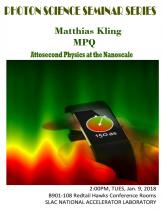Speaker: Matthias F. Kling, MPQ
Program Description
One of the most fundamental processes in nature is light-induced photoemission of electrons. When an electron is photoemitted inside a solid, it can undergo elastic and inelastic collisions before escaping from the surface. The mean free path of both types of collisions depends on electron energy and typically lies in the nanometer scale for sub-keV electron energies in most solids. Earlier work showed experimental and conceptual problems for determining the inelastic scattering mean free path, in particular for energies below 100 eV. Since the characteristic scattering time scale is in the attosecond regime, attosecond technology provides an opportunity to directly access electron scattering in the time domain. Such studies have, however, been limited to the investigation of metals or adlayer-covered metals, and accumulative charging of dielectrics prevented their implementation on dielectrics. We have overcome this problem by using nanoscopic dielectric targets in a continuous beam, replacing the nanoscopic solid for each laser shot [1]. Our studies reveal that the observed streaking delay for electrons emitted from SiO2 nanoparticles is almost entirely determined by the inelastic scattering time [2]. Additional effects of the elastic scattering time strongly depend on the materials permittivity, and are found to cancel in the permittivity region of typical dielectric materials. Our results signify that experimentally accessible relative streaking delays serve as a direct clock for inelastic scattering times in dielectrics. The approach for clocking inelastic scattering times was demonstrated on SiO2, but should be transferable to other dielectrics, including water.
Illumination of nanoscale molecules and solids with laser pulses of well-defined waveform enables spatio-temporal tailoring of electron and induced nuclear / molecular dynamics. We have investigated fundamental ponderomotive acceleration and scattering dynamics including multi-electron effects in clusters [3], nanoparticles [4,5], and molecular adsorbates on nanoparticles [*], implemented attosecond near-field sampling [6,7], and probed structural deformations of large molecules [8] and nanoparticles [*] via femtosecond electron and x-ray diffraction. A brief overview over these recent experiments will demonstrate advances in probing ultrafast, complex multi-electron dynamics in molecules and nanoscale materials, and show exciting opportunities for non-linear and coherent diffractive imaging on attosecond timescales using bright attosecond light sources.





